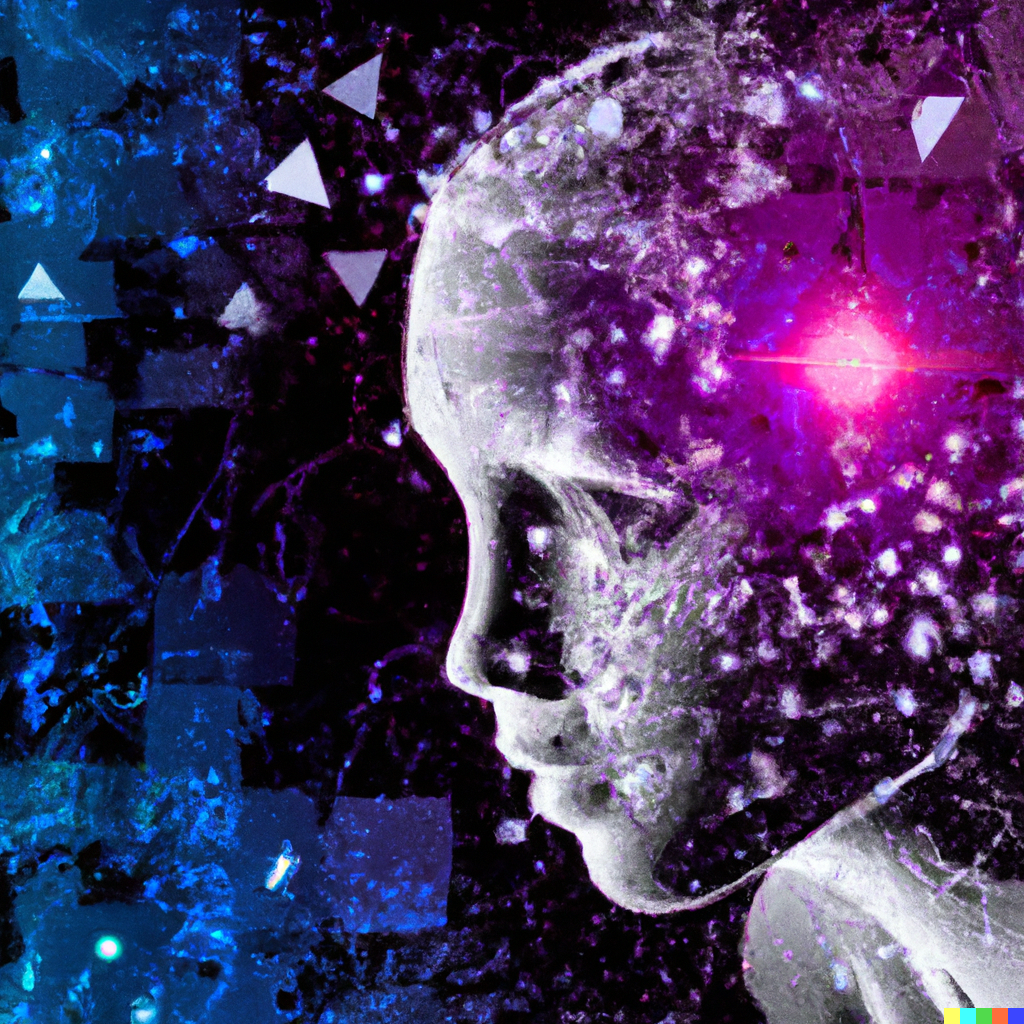Check out the Squall’s followup AI story!
ChatGPT, the world’s most advanced and fastest-growing artificial intelligence, is here. Are we taking a step forward or a step back?
WRITTEN BY BROCK McINTYRE
We’ve all been there. It’s 9:00 PM on a Friday night and you have a paper due at midnight. You have three options. You can spend the next three hours cranking it out (or 2:59 to be specific, so you hit that 11:59 deadline), you can blow it off entirely, or you can write it in less than 30 seconds.
How is that possible, you ask? Only with the new Artificial Intelligence (AI) program, ChatGPT, which has been storming the internet since its November release. ChatGPT acquired over a million users in its first week, ten times as fast as a popular platform like Instagram took to hit that benchmark. With almost limitless possibilities at any user’s fingertips, it’s not hard to see why.
Though the technology is relatively new, word of this program has obviously spread quickly around the world, including the hallways of Dexter High School. Seniors Lucas Greatorex and Griffin Patel share their thoughts on this controversial innovation.
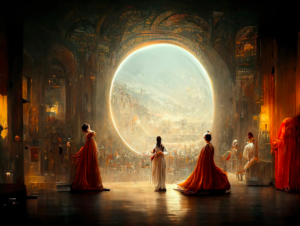 MANUFACTURED MASTERPIECE: This is an art piece titled “Théâtre D’opéra Spatial.” Despite being entirely AI generated, it still managed to win the Colorado state fair’s art competition to the chagrin of the human artists against which it competed.
MANUFACTURED MASTERPIECE: This is an art piece titled “Théâtre D’opéra Spatial.” Despite being entirely AI generated, it still managed to win the Colorado state fair’s art competition to the chagrin of the human artists against which it competed.
“I think there’s too much attention on the small amount of potential negatives of chat GPT and not enough attention on the large amount of positives,” Greatorex stated, open to what could be achieved with such a tool.
“People have been cheating on everything since the first century, ChatGPT just makes it easier. It’s always gonna come down to a person’s character if they’re willing to cheat, ChatGPT just makes it a bit more tempting for the weakwilled,” Patel pointed out, sharing that in his view of cheating ChatGPT won’t change much.
Before diving further into the pros and cons, however, here is a basic rundown of the program.
ChatGPT was developed as a chatbot by OpenAI, an AI development company that rose to fame with their other popular software, DALL-E, an artificial artisan likely responsible for much of the AI-created art that you may have seen trending. What sets ChatGPT apart from other chatbots is its expansive range of capabilities. With such an advanced, ever-evolving program, to list them all would be a fool’s errand as such a list would likely be outdated by the time it is finished. However, it soon becomes clear that with the ability to turn a simple prompt into an entire essay, ChatGPT can be a powerful tool…and also a dangerous weapon. Consequently, it has become a growing concern for teachers everywhere, and the DHS faculty are no exception.
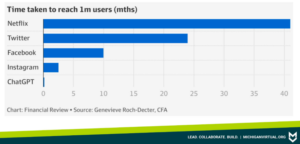 STARTLING STATISTICS: A chart, courtesy of Michigan Virtual, shows the rise in popularity of ChatGPT in comparison to other popular platforms. It took Netflix more than three years to reach one million users while Chat GPT reached that threshold in less than one month.
STARTLING STATISTICS: A chart, courtesy of Michigan Virtual, shows the rise in popularity of ChatGPT in comparison to other popular platforms. It took Netflix more than three years to reach one million users while Chat GPT reached that threshold in less than one month.
There are certainly potential uses that could benefit the educational system, but there are equally as many drawbacks that could compromise that system. Through a series of emails, The Squall interviewed multiple teachers to get their thoughts on the new technology, and received very diverse results.
After interviewing several members of the English Department, the profound negative effects that programs like ChatGPT could have on education, specifically literature classes, becomes clear. Word of this application and the dangers it could pose spread quickly to teachers, and ours at the high school have been working diligently to find a solution.
Some, such as English teacher Patrick Stolkey, are aware of the fact that programs like ChatGPT could forcibly change teaching methods.
“All assessments [would] need to be written in class without devices,” Stolkey said. “That’s the only way to assess what a student can do without outside influence.”
Fellow English colleague Ellen Doss shared Stolkey’s view.
“Now I’m afraid that anything done at home or with access to the Internet can be done or heavily assisted by AI, so those types of assignments may have to be abandoned,” Doss said.
She also expressed that this shift would be a shame due to the recent integration of online work in classrooms.
Another English teacher, Zach Lindke, indicated that, “the rift between take-home essays and in-class essays is shocking,” opening up the possibility that students have already been using the internet to influence their writing before ChatGPT came into the picture.
Judging by these comments, we could soon see a potential shift toward more in-class assignments if this technology continues to advance.
Alternatively, Media teacher Barry Mergler proposed that another solution would be to, “teach young people about using AI technology responsibly…without sacrificing their creative identities.”
To emphasize the power of ChatGPT, all of the original emails with interview questions sent out to teachers were entirely AI generated, something that none of those interviewed had detected once asked about it. Many were shocked at this revelation, which just went to show how convincingly the state-of-the-art AI can mimic human writing.
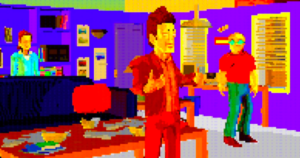 INFINITE ENTERTAINMENT: What’s the deal with AI Seinfeld? Above is a screenshot of the AI-generated show “Nothing, Forever,” streaming 24/7/365 on Twitch. The show continually animates itself and is able to produce a Seinfeld-like show that can run forever.
INFINITE ENTERTAINMENT: What’s the deal with AI Seinfeld? Above is a screenshot of the AI-generated show “Nothing, Forever,” streaming 24/7/365 on Twitch. The show continually animates itself and is able to produce a Seinfeld-like show that can run forever.
Teachers shared their abstract thoughts on the development of AI as well, such as Doss, who was reminded of something from Orwell’s timeless 1984.
“Remember… the ‘machines’ in the Ministry of Truth that churn out novels and pop songs and propaganda of all sorts?” Doss asked. “The fact that ChatGPT-generated work sounds so much like actual writing is a pretty vivid illustration of how rather “robotic” much schoolwork and writing of all kinds has become.”
Furthermore, it’s not so outlandish anymore to think this rapid advancement of technology has led us dangerously close to a dystopian future such as one run by “Skynet,” as wryly mentioned by Mergler.
“I’m worried that the more we use technology, the less capable we’ll be on our own,” Lindke said about his concerns of this technology’s effects on humanity.
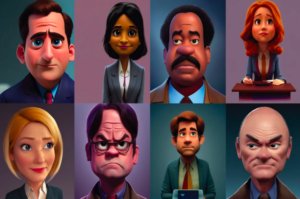 ARTIFICIAL OFFICE: Here’s what AI tools were able to create when prompted to make characters from The Office in the animated style of Pixar. Featured, clockwise from top left, are Michael, Kelly, Stanley, Pam, Creed, Jim, Dwight, and Angela.
ARTIFICIAL OFFICE: Here’s what AI tools were able to create when prompted to make characters from The Office in the animated style of Pixar. Featured, clockwise from top left, are Michael, Kelly, Stanley, Pam, Creed, Jim, Dwight, and Angela.
Superintendent Dr. Chris Timmis calls the latest development, ChatGPT, “The Model T of AI.” While he is intrigued by the advancements in AI technology, he is also aware of the major changes that it will create for educators.
When sitting down with Timmis to discuss the subject, he expanded on his pragmatic outlook. He stressed the potential for individualized learning that could come with a union of education and artificial intelligence. Timmis theorized that students would have the ability to create their own projects and assignments using AI, allowing them to pursue passions and interests. Teachers could shift more towards a role as a “navigator” of sorts, providing students with guidance and a more personal, one-on-one school experience.
“Whenever humans have been confronted with rapid changes in technology, our society struggles through it until it becomes the new norm,” Timmis expressed, confident that we can eventually integrate AI in useful ways in many areas of life.
Acknowledging that weighing potential dangers and ethical implications will be important, the conversation concluded with Timmis stating that, “we’re teetering on the edge of a huge change,” regardless of what kind of change it is.
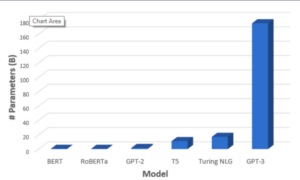 CONFOUNDING CAPABILITIES: A graph displays the intelligence (measured in parameters) of the current version of ChatGPT, GPT-3, as compared to similar programs. GPT-4 is predicted to have over one trillion parameters. GPT-4 will be the Mach-E to GPT-3’s Model T.
CONFOUNDING CAPABILITIES: A graph displays the intelligence (measured in parameters) of the current version of ChatGPT, GPT-3, as compared to similar programs. GPT-4 is predicted to have over one trillion parameters. GPT-4 will be the Mach-E to GPT-3’s Model T.
Many teachers that were interviewed shared Timmis’ viewpoint of AI allowing teachers to shift to a role more focused on a mentor relationship with students. They also clearly had many potential applications in mind, such as Stolkey’s description of an impartial interpreter of data.
“The interpretation of data by humans is flawed, but if we can eliminate confirmation bias with AI, that can be really exciting for all applications,” Stolkey said. “If it helps me to figure out more easily what my students need and how to best provide it, we can see a revolution in education that might be more individualized.”
Through rigorous testing, teachers have begun to find limitations, including tools to detect AI influence. Most teachers share the sentiment that there are some human traits that cannot be learned by AI, at least as of now. Many teachers spoke of the unique relationship between a teacher and their students, and how AI cannot form that connection.
Stolkey cited humor as another example of something that AI can’t understand, predicting that if they could, “there’s no way for us to compete—stand-up comics take months to refine their act and tweak what doesn’t work. If AI can do the same thing in milliseconds, we’ll all have no way to compete in any arena.”
Additionally, within two months of its release, ChatGPT has already resulted in the development of countermeasures, such as GPT-Zero and OpenAI detector, which are both websites to detect AI influence in a text. Sites like these are still underdeveloped and unreliable, but could turn into another solution to combat AI-written work in schools.
 AI ART: This is what OpenAI’s DALL-E 2 program created when prompted to create “an Andy Warhol-style painting of Coca-Cola bottles.”
AI ART: This is what OpenAI’s DALL-E 2 program created when prompted to create “an Andy Warhol-style painting of Coca-Cola bottles.”
There are certain ethical questions that must be asked when a groundbreaking tool like ChatGPT becomes available, such as the titular question, “Are we going too far?” If this technology keeps advancing at the current rate, both the availability and/or capability of AI will change the education system…for better or for worse. Do the risks outweigh the benefits? What will a classroom look like in 10 or 20 years? What about society? Are we engineering our own destruction? Perhaps these are just rhetorical questions, but they are certainly worth considering.
It has been estimated that by 2035, artificial intelligence will rival human intelligence, but that date continues to be pushed forward with some saying 2029 or even sooner. With figures like these, GPT-4 (the next version of ChatGPT) on the horizon, and Microsoft pouring billions into OpenAI, who knows what is to come with the exponential development of AI. It’s impossible to predict the future in such a fast-moving world. We’ll just have to wait and see… but it doesn’t seem like it will be a long wait.

